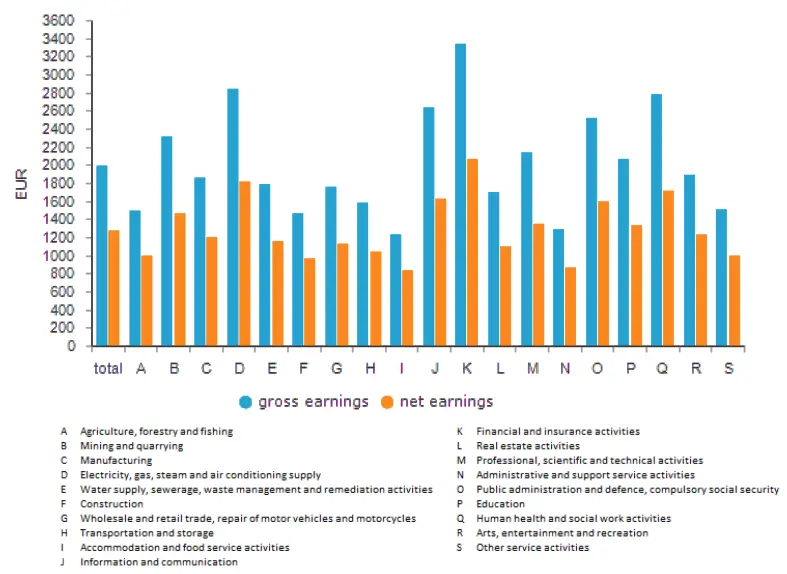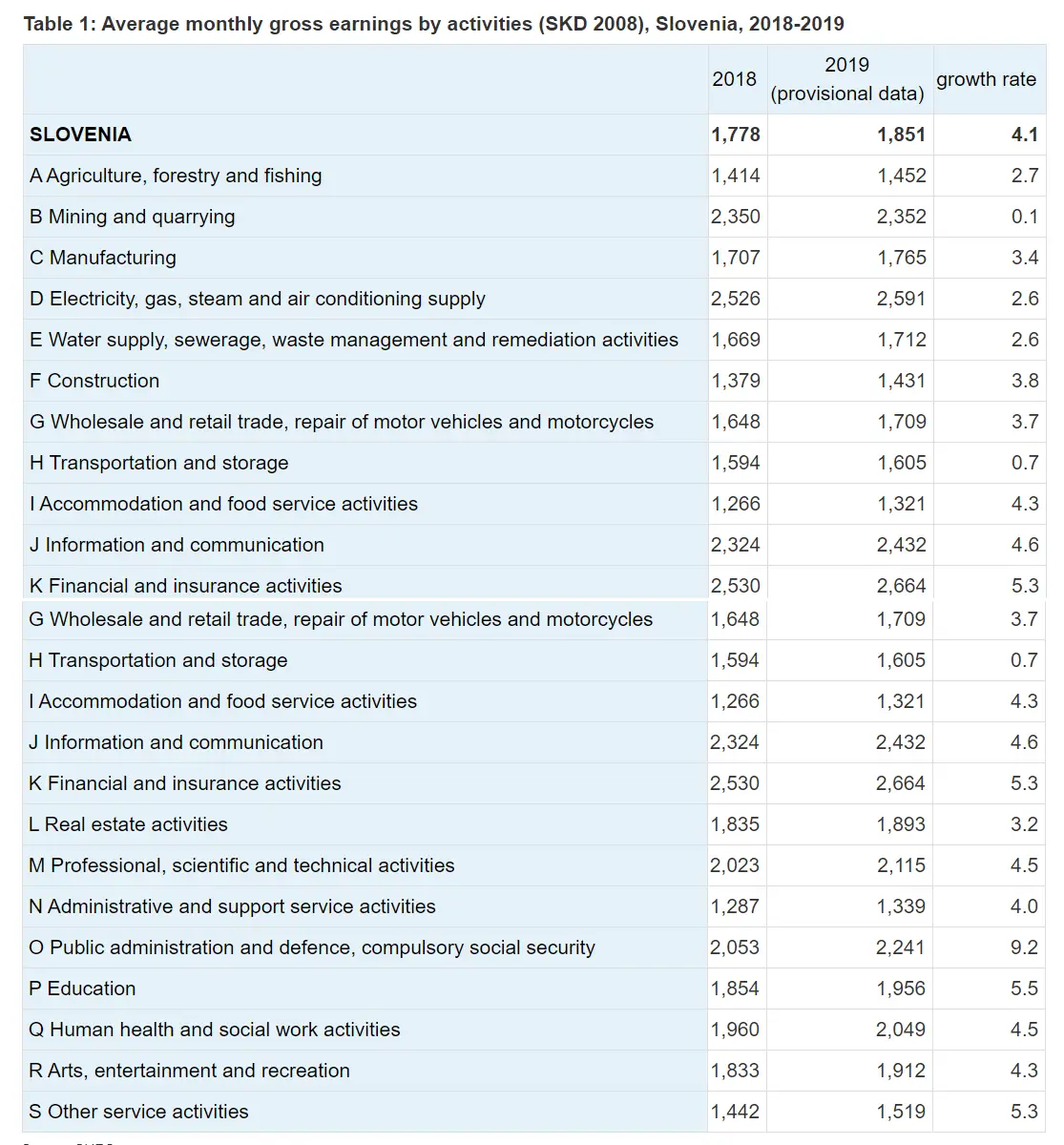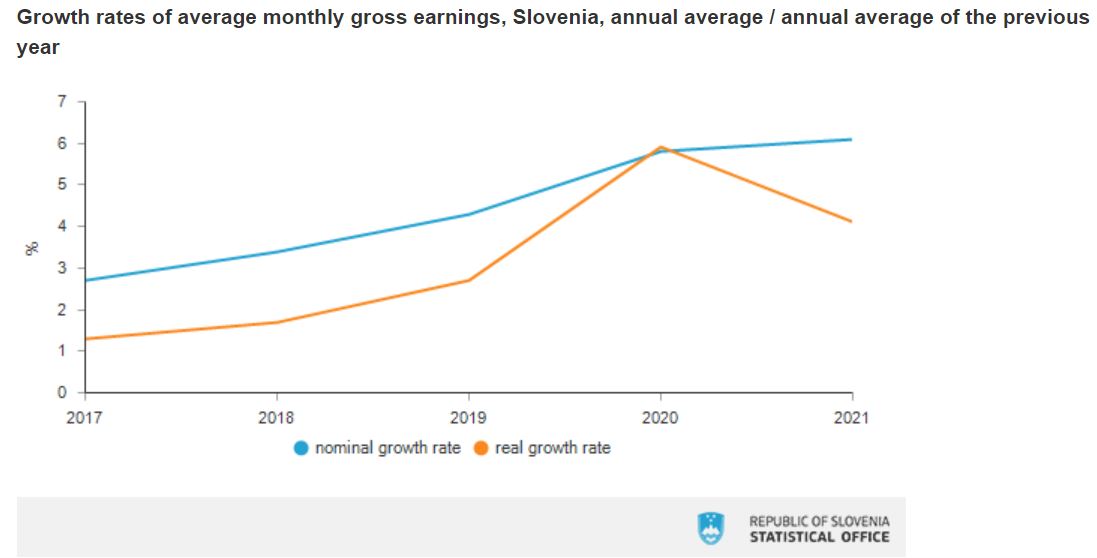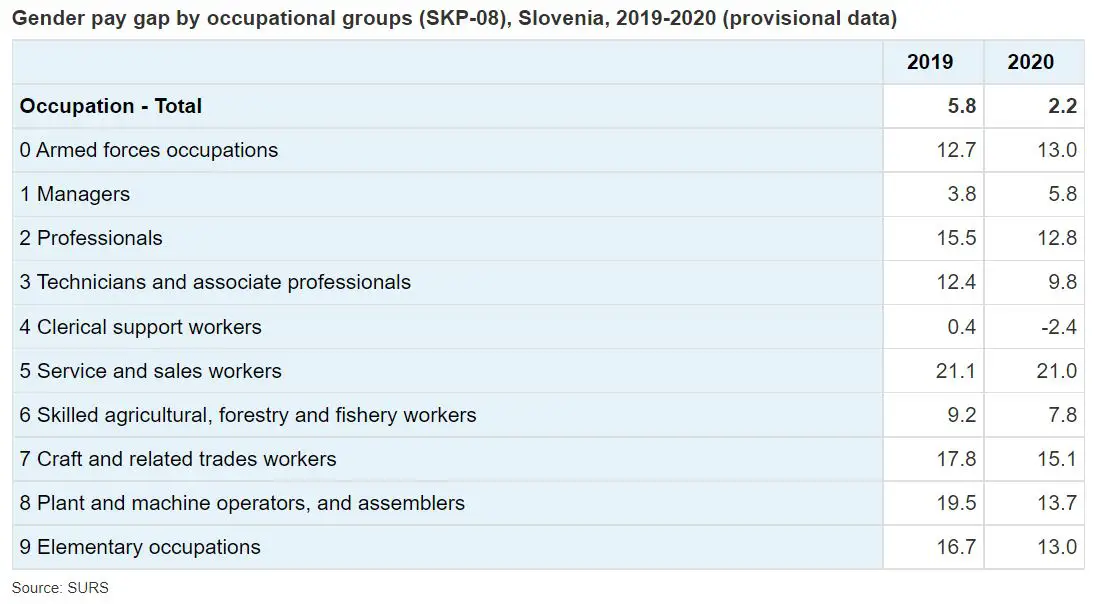Ljubljana related
STA, 28 March 2022 - Hourly labour costs averaged EUR 21.1 in Slovenia last year, well below the EU and eurozone averages of EUR 29.1 and EUR 32.8, respectively, despite growing at a brisk pace, show the latest Eurostat data.
At 6%, Slovenia had the third-fastest rate of increase last year behind Lithuania (11.9%) and Estonia (6.6%).
Hourly labour costs ranged from almost EUR 47 in Denmark and EUR 43 in Luxembourg to EUR 7 in Bulgaria and EUR 8.5 in Romania.
Slovenia's labour costs place it in the company of Mediterranean member states, between Spain (EUR 22.9) and Portugal (EUR 16).
Other Central and Eastern European member states had significantly lower costs.
The figures cover all major economic sectors except agriculture and the public administration.
STA, 15 February 2022 - The average gross pay in Slovenia rose by 6.1% in nominal terms in 2021 to EUR 1,970, the fastest pace in five years. The increase was almost equally driven by the public and private sectors, show the latest Statistics Office figures.
While the nominal increase is the fastest in five years, the real increase was a more modest 4.1% due to high inflation last year.
The average pay rose by 6.5% in the public sector, to EUR 2,337, and by 6.1% in the private sector, to EUR 1,941.
In December, the average wage dropped by a percent compared to the month before, which the statisticians attribute to lower Christmas bonuses paid out for December since most such bonuses come with November wages.
The average net pay rose by 5.1% in nominal terms and 3.1% in real terms to EUR 1,270.
STA, 9 February 2022 - A total of 46% of Slovenian employers intend to raise wages by 5% in the first half of this year, shows Manpower's survey on salary and employee benefits trends. Employers cite retaining talent in their organisations as the main reason for the increase.
According to Manpower, 25% of the employers expect to raise pay between 6% and 10%, 4% expect a rise of 11-15%, and 1% a rise of more than 21%.
A total of 24% of the employers, on the other hand, do not intend to increase pay.
Although the majority of the employers plan to increase wages, 74% do not see the need to increase other benefits and financial incentives.
In addition, 43% of the country's employers expect to increase wages for all employees in the company in the first half of 2022, whereas 12% will do so for 50-80% of their employees. 21% of the employers will do this for between 20-50% of their staff, and 24% intend to increase wages for up to 20% of workers.
The main aim of employers seems to be to retain talent in their firms. "When asked whether the planned increase in salaries and/or additional benefits is more related to retaining or attracting new employees, 68% of Slovenian employers said it is a retention measure, while 14% said it is a measure to attract new employees," Manpower said.
Planning to announce wage increases to retain staff are most companies in manufacturing, IT, consulting services, banking, insurance and finance, telecommunications, science, healthcare and pharmaceuticals, education, transport and logistics, and construction.
Tourism, car industry and outsourcing are the industries where most companies are expecting pay increases to attract new workers.
The survey notes that the results may have been influenced by employers' behaviour to align the minimum wage with consumer price inflation - but only in industries where the average wage is lower or where a higher share of employees are paid the minimum wage.
The survey for the first six months in 2022 is part of a wider Manpower survey covering four countries in Southern and Eastern Europe, including Slovenia, Croatia, Serbia, Bulgaria and Bosnia-Herzegovina. In Slovenia, companies from all over the country and from different industries were included. Manpower conducts this survey at the end of each half-year period.
STA, 19 September - The pay gap between men and women in Slovenia narrowed slightly in 2020, by 3.6 points annually to 2.2%, preliminary figures released by the Statistics Office show. The gap in the private sector stood at 6.5% and at 10.7% in the public sector.
Average monthly net pay in the country increased by 5.4% to EUR 1,252 in 2020 over 2019.
Men's average monthly net pay was 0.7% above the average, while women's was 0.8% below the average.
Average net pay increased last year over the year before for men and women, with women's increasing by 7.3% and men's by 3.9%.
Almost 64% of Slovenia's employees received lower monthly net pay than the national average.
The median of the monthly net pay - a value splitting the population into two equal parts - stood at EUR 1,066, and was practically the same for men and women.
Men with higher education meanwhile earned the most last year, with their average monthly pay at EUR 1,774 net, 42% above the national average.
Women with the same level of education earned much less, EUR 1,529 net a month.
The average monthly net pay dropped under EUR 1,000 in the category of women with secondary education, to stand at EUR 977.
For those who have completed only primary school, it stood at EUR 917 for men and EUR 832 for women.
Average monthly pay was below the national average in more than half of all sectors, and below EUR 1,000 in four, the lowest in hospitality - EUR 884.
The electricity, gas and steam supply sector meanwhile had double the monthly net pay in hospitality, followed by financial services and insurance.
STA, 17 May 2021 - The average gross pay in March was EUR 2,010, up 3.3% nominally and 3% in real terms compared to February. The average net pay for March was EUR 1,291, which was 3% higher nominally and 2.7% higher in real terms, the Statistics Office said on Monday. Pay was also higher on an annual basis.
The average gross pay in March this year was 14.3% higher than in March 2020, when the country was gripped by the Covid-19 epidemic. The average net pay rose by 12.6% year-on-year.
Average gross pay for March was also higher on a monthly basis in both the public and private sectors, by 4.1% and 2.8%, respectively.
Compared to February, the average gross pay for March increased the most in financial and insurance services, by 32%, mainly due to higher exceptional payments.
The financial and insurance services also recorded the highest average gross pay in March, totalling EUR 3,345.
By statistical region, gross wages in March were higher across the country, with the biggest increase recorded in the region of Pomurje (6.7%) and the smallest in Central Slovenia (2.1%).

Figure: SURS
Related: Is Slovenia a Rich or Poor Country?
STA, 3 October 2020 - During the Covid-19 epidemic months, only average pay for March was lower compared with that for February, the last pre-epidemic month in Slovenia, while average earnings for April, May and June were higher. Hospitality sector employees saw the biggest drop in average monthly gross pay in that period.
If average pay per employee is calculated on the basis of paid hours, excluding the impact of the furlough scheme compensation, the figure in the April-June period would be higher than February average pay, mostly due to crisis bonuses, show data from the Statistics Office.
On the other hand, employees working in cafes, pubs and restaurants suffered a considerable drop in their wages - their average March gross pay was 977 euro, down some 20% on February. The figure increased somewhat in the following three months, but it did not reach February pay.
In healthcare, social care, financial and insurance sectors, and in electricity, gas and steam supply services average wages increased during the epidemic.
In the public sector, average gross earnings in the March-June period were higher than average gross pay in February.
The average gross earnings of those working in the private sector increased only in April in May compared to February, whereas in March and June, they earned less.
You can explore this data below
STA, 25 September 2020 - The average monthly gross pay in Slovenia stood at EUR 1,851 in 2019, which is 4.1% more than the year before. The figure was higher than the national average for men and lower for women. A total of 64.4% employees got lower pay than the average, the Statistics Office announced this week.
Last year, the average monthly gross pay of men was 2.7% higher than the average and amounted to EUR 1,901. Among women, the figure was 3.3% lower than the average and totalled 1,790 euros.
For 63.2% of employees, the 2019 net pay was lower than the average. The monthly net pay median, which divides the population into two equal parts, was set at EUR 1,026.
The average monthly net pay was lower than EUR 790 for 25% of people, higher than EUR 1840 for 10% of people and higher than EUR 3505 for just 1%.

Last year, only employees in the central Osrednjeslovenska statistical region received an above-average monthly gross pay, which was 11.1% higher and amounted to EUR 2,056.
The lowest average pay was recorded in the Primorsko-Notranjska region, standing at EUR 1,598, down 13.7% on the average.
In 2019, the average monthly gross pay of persons with tertiary education in the public sector was roughly on par with the figure in the private sector.
The former received EUR 2,434 and the latter EUR 2,478. Persons in paid employment with this level of education in public corporations received much higher average monthly gross earnings though (EUR 2,812).
Among employees with secondary education, those employed in the public sector had a slightly higher average monthly gross pay than those employed in the private sector. The opposite was true for employees with only basic education.
In the public sector, the gap between the average monthly gross earnings of women and men was the smallest for persons with tertiary education - a 20.1% gap.
Meanwhile, men with secondary education in the public sector received a 25.9% higher average monthly gross pay than women, while men with only basic education received a 21.3% higher figure compared to women.
In the private sector, the pay gap between women and men in secondary education averaged 15.8% in favour of men. It was highest among employees with tertiary education - a 22.2% gap.
In public corporations, the average monthly gross pay of men with basic education was 28.6% higher compared to women, while this difference was slightly lower among persons with secondary or tertiary education - men received about 25% higher average monthly gross pay than women.
STA, 15 July 2020 - The average gross earnings in May amounted to EUR 1,892.31, down by 2.3% on April nominally and by 3.2% in real terms. The average net wage was EUR 1,244.44, a 1.7% and 2.6% decrease respectively on April, show data released by the Statistics Office on Wednesday.
Year-on-year, average gross earnings increased, in nominal terms by 9.5% and in real terms by 10.8%. The increase was largely the result of temporary stimulus measures related to the Covid-19 epidemic, which were also in place in April.
Compared to April, average gross earnings in May decreased in both sectors, in the private sector by 2.5% and in the public sector by 2.2%. In the institutional sector general government they decreased by 1.9%.
The highest average gross earnings for May were paid in electricity, gas, steam and air conditioning supply (EUR 2,589.33).
Compared to gross earnings for April, average gross earnings for May increased the most in public administration and defence, compulsory social security (by 7.0%) and decreased the most in accommodation and food service activities (by 8.0%).
If average gross earnings for May were calculated by the number of persons in paid employment on the basis of paid hours and not on the basis of the number of persons in paid employment, they would be higher than gross earnings for April in public administration and defence, compulsory social security by 4.8% and in accommodation and food service activities by 1.0%.
More detailed data can be found here
STA, 15 June 2020 - The average net pay in Slovenia in April stood at EUR 1,266, which was 10.5% more than in March nominally and 11.5% more in real terms, the Statistics Office reported on Monday, noting that the increase was related to measures mitigating the impact of the Covid-19 epidemic.
The Statistics Office said the increase was mostly related to the payment of crisis bonuses in line with the relevant legislation and collective bargaining agreements.
The average gross pay was up by 10.2% nominally and by 11.2% in real terms compared to March to EUR 1,937.
In the public sector, the average gross pay for April was up by 10.9% on the monthly basis, while in the private sector, the increase was smaller, at 8.6%.
Sector-wise, the average gross pay was the highest in healthcare and social security (EUR 2,714), where the monthly increase was also the highest, at 27.9%.
Also increasing by more than a fifth was the average gross pay in the hospitality sector (24.2%).
STA, 19 February 2020 - Representatives of tourism companies and of tourism and hospitality trade unions signed on Wednesday an agreement involving a two-stage increase of the lowest basic wages by a total of 10.25%.
The annexe to the collective bargaining agreement for the sector envisages a 5% increase as of 1 March and 5.25% more as of 1 July, as well as a EUR 100 increase in the holiday allowance compared to 2019 to EUR 1,150.
Commenting on the rise, the Tourism Chamber pointed out social partners in the sector had already agreed on a 4% pay increase in 2019.
Also, the minimum wage increased across the board in Slovenia from EUR 886.63 to EUR 940.58 gross, while bonuses have also been excluded from the minimum wage, which is the wage of a large share of tourism and hospitality workers.
According to the chamber, representatives of Slovenian tourism companies have thus shown they are aware of the need to additionally motivate workers in the sector, since they are the key to increasing quality.
The trade unions have for some time been warning about continuing issues, including a lack of staff, chaotic working time, poor working conditions and low pay.
They argue these reasons contributed to the lack of interest for the profession and its increasing dependence on foreign workers and students. This is however at odds with the strategy for the development of Slovenian tourism, which aims to increase quality and prices.






